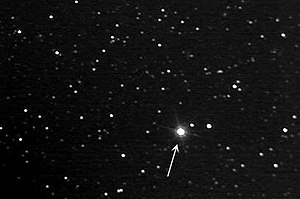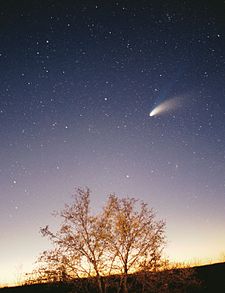Portal:Outer space/Featured/Article

Barnard's Star is a very low-mass star in the constellation Ophiuchus which was discovered by the astronomer E. E. Barnard in 1916. Barnard measured its proper motion to 10.3 arcseconds per year, which remains the largest known proper motion of any star relative to the Sun. Lying at a distance of about 1.8 parsecs or 5.96 light-years, Barnard's Star is the second closest known star system to the Sun and the fourth closest known individual star after the three components of the Alpha Centauri system.
Barnard's Star is a relatively well-studied astronomical object, and has likely received more attention than any other M dwarf star given its proximity and favourable location for observation near the celestial equator. It has also been the subject of some controversy. For a decade from the early 1960s onward, an erroneous discovery of a planet or planets in orbit around Barnard's star was accepted by astronomers. It is also notable as the target for a study on the possibility of rapid, unmanned travel to nearby star systems. Research has focused on stellar characteristics, astrometry, and refining the limits of possible planets.

A black hole is an object predicted by general relativity with a gravitational field so strong that nothing can escape it — not even light.
A black hole is defined to be a region of space-time where escape to the outside universe is impossible. The boundary of this region is a surface called the event horizon. This surface is not a physically tangible one, but merely a figurative concept of an imaginary boundary. Nothing can move from inside the event horizon to the outside, even briefly.
The existence of black holes in the universe is well supported by astronomical observation, particularly from studying X-ray emission from X-ray binaries and active galactic nuclei. It has also been hypothesized that black holes radiate energy due to quantum mechanical effects known as Hawking radiation.

A comet is a small body in the solar system that orbits the Sun and (at least occasionally) exhibits a coma (or atmosphere) and/or a tail — both primarily from the effects of solar radiation upon the comet's nucleus, which itself is a minor body composed of rock, dust, and ices. Comets' orbits are constantly changing: their origins are in the outer solar system, and they have a propensity to be highly affected (or perturbed) by relatively close approaches to the major planets. Some are moved into sungrazing orbits that destroy the comets when they near the Sun, while others are thrown out of the solar system forever.
Most comets are believed to originate in a cloud (the Oort cloud) at large distances from the Sun consisting of debris left over from the condensation of the solar nebula; the outer edges of such nebulae are cool enough that water exists in a solid (rather than gaseous) state. Asteroids originate via a different process, but very old comets which have lost all their volatile materials may come to resemble asteroids.
The word comet came to the English language through Latin cometes. From the Greek word komē, meaning "hair of the head," Aristotle first used the derivation komētēs to depict comets as "stars with hair."

Comet Hale–Bopp (formally designated C/1995 O1) was probably the most widely observed comet of the 20th century, and one of the brightest seen for many decades. It was visible to the naked eye for a record 18 months, twice as long as the previous record holder, the Great Comet of 1811.
Hale-Bopp was discovered on 23 July 1995 at a very large distance from the Sun, raising expectations that the comet could become very bright when it passed close to the Sun. Although comet brightnesses are very difficult to predic] with any degree of accuracy, Hale-Bopp met or exceeded most predictions for its brightness when it passed perihelion on April 1, 1997. The comet was dubbed the Great Comet of 1997.
The passage of Hale-Bopp was notable also for inciting a degree of panic about comets not seen for decades. Rumours that the comet was being followed by an alien spacecraft gained remarkable currency, and inspired a mass suicide among followers of the Heaven's Gate cult.